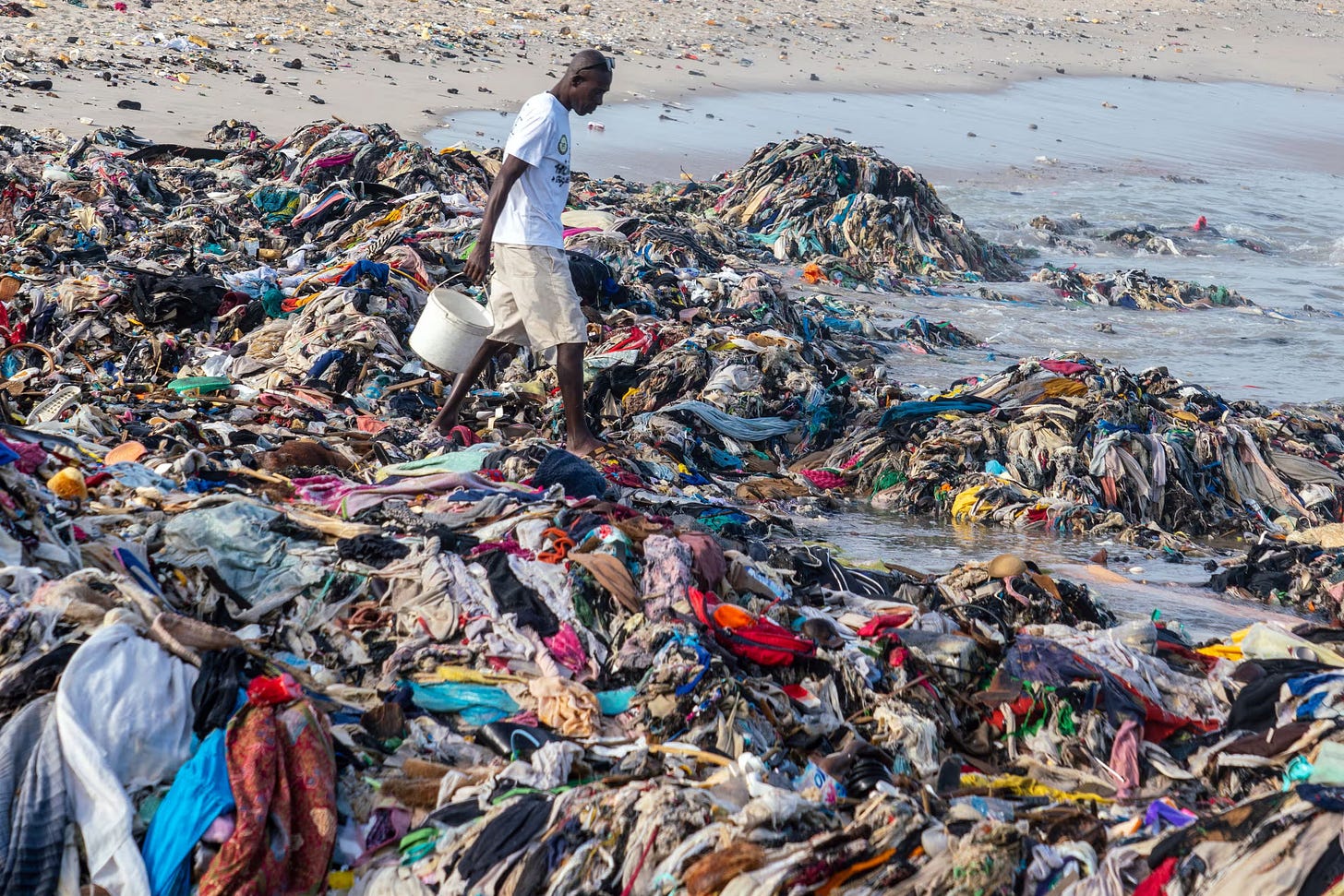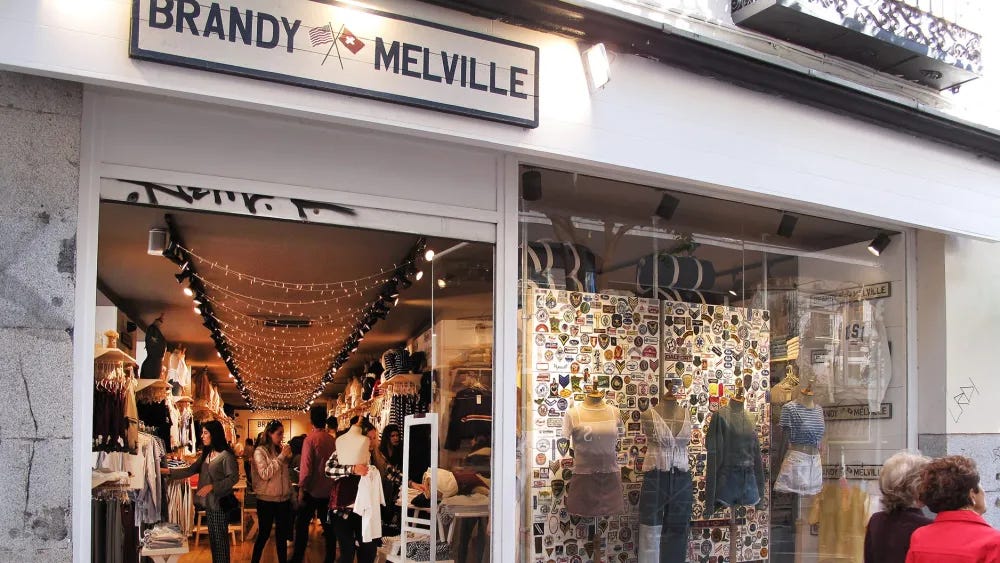A documentary can’t kill Brandy Melville
HBO's latest deep dive into the Brandy universe does little 'uncovering.'

In 2009, Brandy Melville opened their first location in the U.S. in Westwood, California. The location was perfect. It was adjacent to the UCLA campus and an audience of thousands of college-aged women looking for cute, cheap clothes.
An article published in UCLA’s Daily Bruin in November of 2009 perfectly summed up the appeal of the retailer with Italian roots: “As far as quality, it is better than Forever 21 [...] a little more expensive, but it’s less expensive than Urban Outfitters or American Apparel,” said Jessy Longo, the Westwood store’s owner and operator of the U.S. division of the brand.
The store’s aesthetic felt different than other fast fashion retailers. It wasn’t the size of a warehouse à la H&M with fluorescent lighting that burned the retinas. It also wasn’t doused in cologne and blasting club-like music or covered in images of half-naked men like Abercrombie. Brandy Melville had hacked the system, operating like a fast fashion company but appearing like a small boutique emanating vintage-y, European coolness.
And the best part was the prices, between $12 and $48, which felt more respectable than buying a Forever 21 tank for $5. Every Brandy tag proudly proclaimed its manufacture in Italy — which wasn’t untrue, but did not signify ethical production either — to further build the facade of a humble, European brand making its mark on American customers.
I was in middle school and high school during the heyday of Brandy Melville from 2014 to 2020. The one-size-fits-all policy didn’t phase me then, but again, I fit their ideal customer type. I was skinny, young, very active on social media and just wanted to look like everyone else, especially the other girls in my grade at school. Fitting into Brandy Melville’s clothes also further validated my disordered eating habits at the time, an experience to which many young girls can speak.
And eventually, after several giddy trips to the store during these years, I became a Brandy girl, Instagram posts and all.


What does the film aim to uncover?
Growing up so invested in the Brandy universe, I had high expectations for the recent HBO documentary Brandy Hellville & the Cult of Fast Fashion, thinking it would uncover some awful things about the company of which I wasn’t already aware. Maybe they had dug up something even worse than the company’s backbone of racism, fatphobia and overall creepiness that had been discussed in articles and YouTube video essays over the past decade.
Yet, the documentary was disappointingly uninteresting. The creators of Brandy Hellville seemed to have made a documentary about Brandy Melville that was so surface-level that their studio-shot interviews and photo slideshows needed to be sloppily dispersed among supplementary clips generally explaining the fast fashion industry and its impacts. The documentary’s lack of organization or a smooth narrative progression makes it a tough watch.
The majority of content exclusively about Brandy Melville features interviews from former retail employees, a former Brandy photographer, a few business and fashion reporters and unidentified former executives from the company, whose interviews were filmed in a tacky, backlit way that obscures their faces.
They discuss the founding of the company, its rapid expansion and impressive revenue. They recount the oddity of a middle-aged man running a clothing empire for young girls and the emotional damage caused by its ‘one size fits most’ policy. They acknowledge how full-body photos of 18 to 21-year-old employees were sent to a group chat of middle-aged men who often fired girls based on their appearance.
For a documentary based on interviews, I expected to learn of upsetting anecdotes addressing further issues about Brandy that I hadn’t already read online previously. Perhaps they weren’t asking the ones in front of the camera the right questions.
The doc’s discussion of the larger fast fashion crisis

The richer, secondary content of the documentary focuses on the global fast fashion crisis, featuring poignant interviews filmed in Accra, Ghana where residents and non-profit organizers stand among piles of discarded clothing that have been deposited there by the UK, US and China.
In one shot, a Brandy Melville tag sits among other t-shirts in a pile along the streets of Accra in a forced way of combining the two topics of a brand scandal and a larger humanitarian crisis. Here, I was hoping for more statistics about Brandy Melville’s environmental impact or the sheer number of styles the brand produced every month to provide direct evidence of the company’s complicity in the ongoing textile waste problem.
While addressing the environmental crisis caused by fast fashion, some of the interviewees encourage involvement in the sustainable fashion movement and a former retail employee shares the groundbreaking advice that now she thrifts a lot of her clothing.
To its credit, the clips shot in Ghana highlight the important work of the Or Foundation, a nonprofit researching the effects of fast fashion and initiating projects that promote a circular economy. But if you’re looking for better documentaries on the fast fashion crisis, might I suggest Made in Bangladesh and The True Cost?
The juiciest bits of the documentary delve into just how disgusting the Brandy Melville founders are, with screenshots of antisemitic and derogatory messages these men were sending each other in a private group chat. Yet, these photos were already published back in September 2021 when all major publications caught wind of the troubling inner workings of the company and the mass quitting of Brandy employees across America. These supposed jaw-dropping tidbits in the documentary felt like reiterations of Daily Mail headlines regarding the company. And still, Brandy Melville has survived these criticisms to this day.
I fear Brandy Hellville marks a new era of documentaries that regurgitate previously published – and widely known – information to viewers for the sake of making the first documentary about a topic. While watching, I consistently noticed subtopics that I wished were expanded upon. I was looking for more information about where Brandy Melville is now and how the brand stays afloat and even thrives amidst its decade of controversial practices.
The documentary interviewed previous Brandy employees who explained their relegation to working in the stock rooms because they weren’t white and blond. Other screenshots of texts from Brandy’s owner Stephan Marsan ordered the firing of employees based on their appearance. Broader implications of hiring and firing based on race, practices, which are illegal under federal law, were not discussed.
As New York Times movie critic Alissa Wilkinson notes in her review, the cult-like structure of the company exists, as implied by the documentary’s title. Marsan and other executives are the cult leaders, who set expectations for cult members (Brandy employees and customers) with restrictions set in place by the company’s limited size range and exclusionary brand image. Former employees and journalists loosely defined this structure, but never categorized it as cult-ish.
By implementing a few more interviews with experts in various fields, – law, psychology, and business strategy – this documentary could have been saved from its forgettable status.
Can Brandy Hellville incite real change?

As sketchy and discriminatory the company is, I don’t think a documentary will shut all its doors down, especially one as lacking in depth as Brandy Hellville. Regardless of the documentary’s good intentions, its ability to prompt a change in consumer behavior all boils down to a question of audience.
Brandy Melville’s target customer has always been in her tweens and teens and is highly immersed in social media as a form of entertainment and news. To truly prompt a Brandy Melville boycott, the documentary must reach these young girls who hold purchasing power.
Yet viewers of Brandy Hellville are likely in their twenties and thirties, watching partially for nostalgia’s sake and having moved on from shopping at the store that’s not meant for adult bodies. They most likely caught wind of the documentary from articles in The New York Times or Time Magazine or The Guardian.
Not to criticize Gen Alpha and younger Gen Zers, but unless the more shocking parts of the documentary wind up on their news outlets such as on TikTok or Instagram reels as pirated clips, today’s generation of Brandy Melville customers will unknowingly continue to keep the company alive, one flimsy cotton tank at a time.



